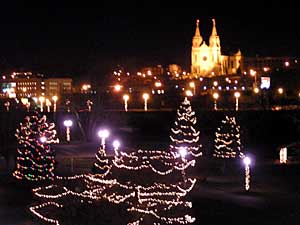|
Audio
Photos
Resources
Respond to this story
|
Sioux Falls goes from cow town to metro
December 17, 2004
 |
| Downtown Sioux Falls from a viewing tower at Falls Park. Downtown has transformed from a skyline of smokestacks and feed mills in the last 30 years. (MPR Photo/Cara Hetland) |
Sioux Falls, S.D. — Downtown Sioux Falls looks a lot like a big city. Art sculptures line the main drag, Phillips Ave. There's a hotdog vendor during the lunch hour, tables outside on summer nights, and next year there will be strolling musicians and carriage rides. New businesses have migrated downtown. Old warehouse space has been transformed into apartments.
Steve Metli, Sioux Falls' city planner, has been at his job for 30 years. He's helped the city reclaim some downtown real estate and show off the river. Now, Metli says, people need to live there.
 | |||
"I think you're going to see a trend over the next 20 years of people wanting to move back into downtown areas, where they can get out and walk and go to a coffee shop, or go to a gift shop or dress shop," says Metli.
About 1,000 people call downtown Sioux Falls their neighborhood, and Metli predicts that number will be grow to 5,000 in the next few years.
The city took its name from the Big Sioux River and a natural waterfall. It took 30 years and $15 million to complete four blocks of new road and redevelopment. That lets people finally see and live along the river.
Three decades ago, the Big Sioux River was a waste dump and the falls foamed with pollution runoff. Metli remembers a time when visitors to Falls Park remained in the safety of their car.
 | |||
"Because it was pretty much a park where a lot of thugs and indigents hung out," says Metli. "Now you go out down there at 9 or 10 o'clock and you'll see lovers, teenagers, middle-agers, and seniors walking through the park holding hands."
Not everyone says a nice park can transform a downtown. John Adams, chairman of the University of Minnesota geography department, says it takes a lot more. He says Sioux Falls' gains come at the expense of other communities in South Dakota, because young people from those communities migrate to Sioux Falls, the state's largest city. Adams says planners can't take credit for the growth spurt.
"When the city does something like clean up the river or rebuilding this or modifying that, the city wants to take credit for the activity as the cause of the other things going on," says Adams. "Actually it's a reciprocal process. It's a little hard to demonstrate what causes and effects are because they're mutually reinforcing."
Adams says businesses expand to Sioux Falls because the city is growing. The city grows because businesses expand. It's just not always clear which comes first. Adams says it has to happen at the same time and it's not something planners can plan, just take advantage of.
 | |||
Daniel Stadema is executive director for Mainstreet Sioux Falls, an organization that works to promote downtown retailers. Stadema says people need a reason to come downtown.
"Development in a downtown has special challenges than other areas. In an open corn field, you build the sewer and the streets and you're ready to go," Stadema says. "In downtown, you have some historic guidelines -- buildings on the historic register, and redevelopment needs which can be more expensive."
Despite all the renovations going on downtown, Stadema says in some respects Sioux Falls is falling behind. To stay competitive with cities like Des Moines, Omaha or even Fargo, Sioux Falls has to be able to bring lots of people downtown.
There's a proposal now for a new 12,000-seat arena, which would host concerts and sports events. Stadema says that would generate the traffic that will spur even more growth. No one is saying what it'll cost yet. The arena proposal will be put to a public vote in 2005.
|
News Headlines
|
Related Subjects
|
